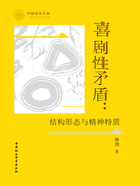
上QQ阅读APP看书,第一时间看更新
第一章 喜剧性矛盾与六大喜剧理论模式
面对丰富繁多的喜剧理论遗产,本书主要关注的是它们对喜剧性矛盾的理解和阐释。因此,有必要首先通过对六种喜剧理论模式所论及的喜剧性矛盾的分析,来厘定每一种模式理论效应的范围和局限,以此探寻喜剧性研究的理论基点。
六种喜剧理论模式的划分,出自波兰当代学者Б.德泽米多克的归纳,具体包括:(1)喜剧客体的否定特征论,或者从心理学上讲,喜剧体验优于体验客体的理论(the theory of the negative feature of the comical object or,psychologically speaking,the theory of the superiority of the experience of the comical over the object of the experience);(2)退化论(the theory of degradation);(3)对比论(the theory of contrast);(4)不和谐论(the theory of incongruity);(5)偏离常规论(the theory of deviation from a norm);(6)混合主题论(the theories of mixed motifs)。[1]较之于“客观论”“主观论”和“关联论”的三分法,Б.德泽米多克的“六分法”突出了每一种模式的理论要点,虽难免遗漏,但相对来说较为合理。本书大体上借用“六分法”所提供的理论线索,由此展开对喜剧性矛盾的分析和阐释,引文一般参照俄、英两种译本。